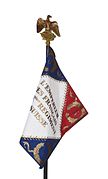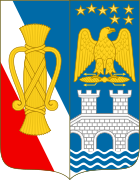French Imperial Eagle

TheFrench Imperial Eagle(French:Aigle de drapeau,lit. 'flag eagle') refers to the figure of an eagle on a staff carried into battle as a standard by theGrande ArméeofNapoleon Iduring theNapoleonic Wars.
Although they were presented withregimental colours,Napoleon's regiments tended to carry at their head the Imperial Eagle.
History
[edit]
On 5 December 1804, three days after hiscoronation,Napoleon I distributedaiglesbased on theeagle standardsof theRoman legions.The standards represented the regiments raised by the variousdepartments of France,and were intended to institute feelings of pride and loyalty among the troops who would be the backbone of Napoleon's newImperial regime.Napoleon gave an emotional speech in which he insisted that troops should defend the standards with their lives. This event was depicted inThe Distribution of the Eagle Standards,an 1810 painting byJacques-Louis David.[1]
The original design was sculpted byAntoine-Denis Chaudetand then copies were cast in the workshop ofPierre-Philippe Thomire,with the first eagles presented on 5 December 1804.[2]It was abronzesculpture of aneagleon a plinth, with one claw resting on "Jupiter's spindle ".[2]weighing 1.85 kg (4 lb), mounted on top of the blue regimental flagpole. They were made from six separately cast pieces designed alongRomanlines and, when assembled, measured 310 mm (12 in) in height and 255 mm (10 in) in width.[2]On the base would be the regiment's number or, in the case of theImperial Guard,Garde Impériale.The eagle bore the same significance to French Imperial regiments as the colours did to British regiments - to lose the eagle would bring shame to the regiment, who had pledged to defend it to the death. Upon Napoleon's fall, the restored monarchy of KingLouis XVIIIordered all eagles to be destroyed; only a very small number were preserved. When the former emperor returned to power in 1815 (known as theHundred Days), he immediately had more eagles produced, although the quality did not match the originals. The workmanship was of a lesser quality and the main distinguishing changes had the new models with closed beaks and they were set in a more crouched posture.[3]
-
The Roman Imperial Eagle inspired Napoleon's French Imperial Eagle.
-
French Imperial Eagle of a regiment of theGrande Armée
-
So-called "wounded Eagle" (fr.aigle blessée), Eagle damaged by enemy fire, on display at theMusée de l'ArméeinParis
-
Thecurrent royal house of Swedenretains an imperial eagle on itscoat of arms,as its founder,Jean-Baptiste Bernadotte,was aMarshal of the EmpireandPrince of Pontecorvo.
Captured eagles
[edit]
The first capture of an eagle was most likely during theBattle of Austerlitzin 1805 when the Russian cavalry of the guard underGrand Duke Konstantinoverran the French4thRégiment d'Infanterie de Ligne,taking their flag. Although Napoleon won the battle, the Russians were able to retreat in good order and the eagle was not recovered, much to the emperor's regret.[4]
In 1807, atHeilsberg,the55thRégiment d'Infanterie de Lignewas overthrown by Prussian cavalry and Russian infantry. An eagle was lost and several officers, including a colonel, were killed. The eagle was captured by NCO Anton Antonov of thePernov Musketeers.Prussian historians dispute this, claiming that thePrittwitz Hussarscaptured the eagle.[5]
In 1807, nearEylau,the18thRégiment d'Infanterie de Lignelost its flag and eagle to the RussianSt. Petersburg Dragoons.[6]In 1812, atKrasnoi,the 18thRégiment d'Infanterie de Ligneagain lost its eagle and was "virtually destroyed" by the RussianLife Guard Uhlans.[7]
In 1808, at theBattle of Bailén,an entire French corps led by GeneralPierre Dupontsurrendered after being defeated by a Spanish army led by generalsFrancisco Javier CastañosandTheodor von Reding;this was the first surrender of an Imperial field army. As part of thecapitulationterms, the French gave up their flags and banners, including three eagles. These eagles were kept in theCathedral of Sevilleuntil they were recovered by the French in 1810 and sent back toParis.[8]
The first French eagles to be captured by the British were taken during theInvasion of Martiniqueincluding the Eagle of the 82nd French Regiment of the Line. Subsequently the87th Regiment of Foottook an Imperial Eagle at theBattle of Barrosaon 5 March 1811. At Barrosa, Ensign Edward Keogh and Sergeant Patrick Masterson captured the French Imperial Eagle of the8thRégiment d'Infanterie de Ligne.Keogh only managed to get a hand on the shaft when he was shot, bayoneted, and killed. Masterson took over and, after killing several men, wrenched the Eagle from the dying hands of its bearer, Lieutenant Gazan.[9]
The eagle was taken back to theUnited Kingdomand put on display in theRoyal Hospital Chelsea.It was around 10 inches tall, set on a plinth marked with the numeral8.It was made of silver, but gilded, which led many to think it was solid gold. In fact, the only golden part of the eagle was alaurel wreathwhich hung around its neck. This wreath was an honour conferred upon the 8th Regiment by Napoleon himself, and was not common to all eagles at the time. The gold leaves were presented to a number of regiments that were present at the Battle of Austerlitz by the city of Paris. The eagle's right claw was raised. Beneath it should have been a thunderbolt but, on the 87th's trophy, it was missing. It is believed to have been dislodged during its capture.[10]
Several years later, the eagle was stolen from the Royal Hospital. It was broken from its staff and smuggled away to an unknown fate. Many rumours abounded, the strongest being that it had been repatriated by a Frenchman. More likely it was melted down and sold. The original staff is still held in theRoyal Irish Fusiliers Museum,located in the Sovereign's House onThe MallinArmagh,Northern Ireland.[11]

The British took two eagles at theBattle of Salamancain July 1812. Ensign John Pratt of the Light Company of the30th Regiment of Foot(later 1st Battalion,East Lancashire Regiment) captured the eagle of the22ndRégiment d'Infanterie de Ligne(displayed today in theLancashire Infantry MuseumatFulwood BarracksinPreston, Lancashire),[12]while Lieutenant William Pearce of the 2nd Battalion of the44th Regiment of Foottook the eagle of the62ndRégiment d'Infanterie de Ligne[13](displayed today in theChelmsford MuseuminEssex).[14]
Following the surrender of the French at the capture ofMadridon 14 August 1812, two eagles were found belonging to the13thRégiment de Dragonsand the51stRégiment d'Infanterie de Ligne.[15]

Two of the newer French regimental eagles were captured during theBattle of Waterlooin 1815. The FrenchI Corpsunder the command of theComte d'Erlonwascharged by the British heavy cavalry,commanded by theEarl of Uxbridge;the1st The Royal Dragoonscaptured the eagle of the105thRégiment d'Infanterie de Ligne;(now held at theNational Army Museum,Chelsea)[16]and theRoyal Scots Greyscaptured the eagle of the45thRégiment d'Infanterie de Ligne(now held at theRoyal Scots Dragoon Guards MuseuminEdinburgh Castle).[17]
Before theDuke of Wellingtondied in 1852, he had asked that all his battle trophies be carried at his funeral. As the eagle captured by the 87th Regiment of Foot was not available, it was decided to make a replica. The mould was made byGarrard'sand was designed from a sketch of the original drawn by an officer of the 87th at the time of Barrosa.[18]
The capture of an eagle was celebrated through the addition of the eagle as a symbol or accoutrement to a regiment's colour or uniform. TheBlues and Royals (Royal Horse Guards and 1st Dragoons)(descended from the 1st Royal Dragoons) and theRoyal Anglian Regiment(descended from the 44th Foot) both wear the eagle as an arm badge,[19][20]while the cap badge of theRoyal Scots Dragoon Guards (Carabiniers and Greys)(descended from the Royal Scots Greys) is an eagle.[21]TheRoyal Irish Regimentwear the eagle of the 8th on the back pouch of the officers' black cross belt.[22]
A French Imperial Eagle, which had belonged to the1stRégiment de Grenadiers à pied de la Garde Impériale,was among the items stolen in 1990 from theIsabella Stewart Gardner MuseuminBoston,Massachusetts.[23]The 1stRégiment de Grenadiershad formed two squares at the Battle of Waterloo, one of which was formed around Napoleon himself.[24]In May 2015, the Isabella Stewart Gardner Museum offered a reward of $100,000 for the safe return of the Eagle which remains missing.[25]
See also
[edit]References
[edit]- ^Johnson, Dorothy (2006).Jacques-Louis David: New Perspectives.University of Delaware Press.ISBN978-1611492835.
- ^abcWise, Terence (2012).Flags of the Napoleonic Wars (1): Colours, Standards and Guidons of France and her Allies.Osprey Publishing. pp. 4–6.ISBN9781780966243.
- ^"Eagles".Napoleon Guide.Retrieved23 June2018.
- ^"The Napoleonic Eagle".Rear view mirror.Archived fromthe originalon 23 June 2018.Retrieved22 June2018.
- ^"Hell's Battlefield: Heilsberg".Napoleon, His Army and Enemies.Retrieved22 June2018.
- ^"Rearguard Action Near Eylau: 7 February 1807".Napoleon Series.Retrieved23 June2018.
- ^"Krasnoe".Word Press.Retrieved22 June2018.
- ^"Trofeos de la Batalla de Bailen (Jaén), (19 Julio 1808) (in Spanish)".Napoleon Series.Retrieved25 December2016.
- ^Fraser, p. 137, 138
- ^Fraser, Edward (2015).The War Drama of the Eagles: Napoleon's Standard-Bearers on the Battlefield in Victory and Defeat from Austerlitz to Waterloo, a Record of Hard Fighting, Heroism and Adventure.Palala Press.ISBN978-1341053429.
- ^"Royal Irish Fusiliers Museum".What’s on in Northern Ireland.Retrieved13 June2018.
- ^"The Salamanca Eagle".Lancashire Infantry Museum. Archived fromthe originalon 23 June 2018.Retrieved22 June2018.
- ^Carter, p. 77
- ^"Military exhibition".Chelmsford Council. Archived fromthe originalon 23 June 2018.Retrieved23 June2018.
- ^Porter, Maj Gen Whitworth (1889).History of the Corps of Royal Engineers Vol I.Chatham: The Institution of Royal Engineers.
- ^"The eagle standard of the French 105th Regiment, captured at Waterloo, 1815".National Army Museum.Retrieved22 June2018.
- ^"Treasurers of the Museum".Royal Scots Dragoon Guards Museum. Archived fromthe originalon 23 June 2018.Retrieved22 June2018.
- ^Fraser, Edward (2015).The War Drama of the Eagles: Napoleon's Standard-Bearers on the Battlefield in Victory and Defeat from Austerlitz to Waterloo, a Record of Hard Fighting, Heroism and Adventure.Palala Press.ISBN978-1341053429.
- ^"Orders of Dress for Officers of the Armoured Regiment".Household Cavalry Museum.Retrieved21 October2013.
- ^"Symbols and Badges".Royal Anglian Regiment Museum.Royal Anglian Regiment.Archived fromthe originalon 21 October 2013.Retrieved21 October2013.
- ^"Royal Scots Dragoon Guards: Regimental History and Traditions".Ministry of Defence.Retrieved21 October2013.
- ^"Royal Irish Regiment: History of the Regiment"(PDF).British Army Website.Retrieved21 October2013.
- ^"Eagle Finial: Insignia of the First Regiment of Grenadiers of Foot of Napoleon's Imperial Guard, 1813-1814".Isabella Stewart Gardner Museum.Retrieved12 April2021.
- ^"The Last Squares of the Old Guard".Napoleon, His Army and Enemies.Retrieved13 April2021.
- ^"Gardner Museum announces reward for single item stolen in heist".Boston Globe.12 May 2015.Retrieved22 June2018.
Sources
[edit]- Carter, Thomas(1864).Historical Record of the Forty-Fourth, or the East Essex Regiment of Foot.London: W. O. Mitchell.
- Fraser, Edward (1913).The Soldiers who Wellington Led.London: Methuen. pp. 129–148.




